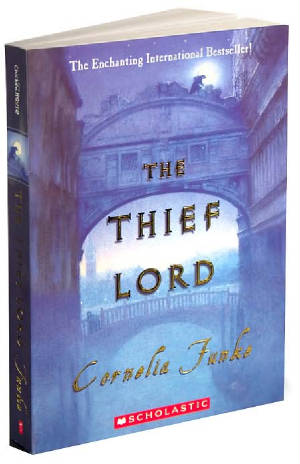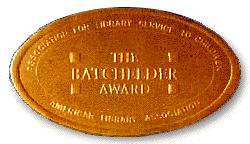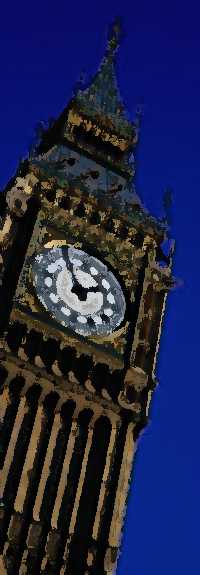|
Time for Bed is a colorful, beautifully written and illustrated book about different animals trying to put their
young to sleep for the night. This book is illustrated by Jane Dyer. Dyer uses large scale watercolor in two page illustrations.
The gentle colors and evening backdrops help project a relaxed feeling while reading the book. Twinkling yellow stars are
intertwined into many of the pictures, which attracts the young reader.
The author, Mem Fox, uses simple, repetitive poetry couplets to describe each of the captivating pictures of the adult
animal tucking their young in for the night. For example, "it’s time to sleep little deer, little deer, The very last
kiss is almost here", gives the child the chance to help read with the repetitive nature of the "little deer, little deer"
and rhyming with "deer" and "here". This brilliant book ends with a human mother tucking her curly headed child into bed and
the last picture has the child in bed asleep. This book, with the warm colors and gentle rhymes, incorporates the feelings
of safety and love between a parent and their young.
Mem Fox uses a mouse, goose, cat, calf, foal, fish, sheep, bird, bee, snake, pup, deer, and human child as the young in
this book. All of these animals are found in North America although Mem Fox spent a lot of her youth in Zimbabwe, Africa.
Fox currently lives in Australia.
 |
 |

The Thief Lord was originally written in German by Cornelia Funke and then translated to English before being released
in Britain. This book is about two orphans, Prosper and Bo, that have run away from their aunt who wants to adopt the younger
and put the older child in boarding school. The children escape to Venice, Italy, where this story is set. They befriend a
gang of homeless children that live in a shut down movie theater. The gang is led by a child named the Thief Lord. They live
off of stealing and selling their loot to Barbarossa’s shop. The aunt hires a disguise infatuated detective and the
children are found at the abandoned movie theater which is owned by the Thief Lord’s father. As secrets are being revealed
about the Thief Lord, their new stealing assignment is to steal a wooden wing that is a key to a magical carousel. Some of
the characters in the book decide to take a ride on the magical carousel while another is tricked into riding it. New friendships
evolve and new decisions about life are made.
The characters are well developed while the ending is abrupt and short. Funke uses descriptive words that allow you to
almost envision the darkness and cold of Venice in the winter. Also, she descriptively writes about the water in Venice, "the
ever-present water swayed beneath the bridges, splashing against the boats and wooden posts, and reflecting back the old faces
of the houses". (p. 22) The illustrator, Christian Burmingham, draws small black and white pictures in front of each of the
short fifty two chapters. The drawings all depict the building and terrain of Venice and helps the reader envision where the
children are.
The Thief Lord is an international bestseller, sold out in Britain in ten days, and has won many awards including the 2003
Mildred L Batchelder Award.
|
Funke,
C. 2003. The Thief Lord. New York:
Scholastic.
ISBN: 043940289x
THis is just a spacer to make this look right.
To learn more about the Mildred L. Batchelder Award, click on the link below:
Mildred L. Batchelder Award information

|
|
 |
 |
Base, G. 2001. The Water Hole. New _____York:
Harry N Abrams. Inc.
ISBN: 0810945681
Graeme Base, the author/illustrator of the book Water Hole, is an artist and musician that was born in England and
moved to Australia when he was six years old. Base has integrated math, science, and literature into one colorful picture
book.
Base uses animals from seven different continents. Each page has an increasing number of animals drinking from a die
cut oval that is decreasing in size. The Water Hole starts with one rhino from Africa and ends up with
ten kangaroos from Australia. Once all the animals have been introduced, the water hole has gone dry. After the animals leave
and a drop of water comes, the water hole is replenished, and all the animals come back.
Base uses watercolor and gouache to illustrate three quarters pages of the animals and the rain on each page turn. Also,
he hides many things in the pictures. For example, there are frogs in the pictures dressed up in vests and jewels, one leaves
with a suitcase when the water hole is dry. Mount Rushmore can be seen behind the trees in the page with the moose from North
America. The Eiffel Tower, Leaning Tower of Pisa, and Big Ben can be seen behind the trees on the page depicting animals from
Europe.
Each of the animals use different noises to communicate in the book. Base translates these in a humorous way. For example,
when the nine tortoises from the Galapagos Islands say, "Scrmph, scrmph, scrmph", Base translates this directly below the
quote by saying, "Okay, which of you wise guys hid all the water?" This is a great book to review numbers, teach about the
cycle of water, and use as an example of vivid, descriptive illustrations for young children.
|
